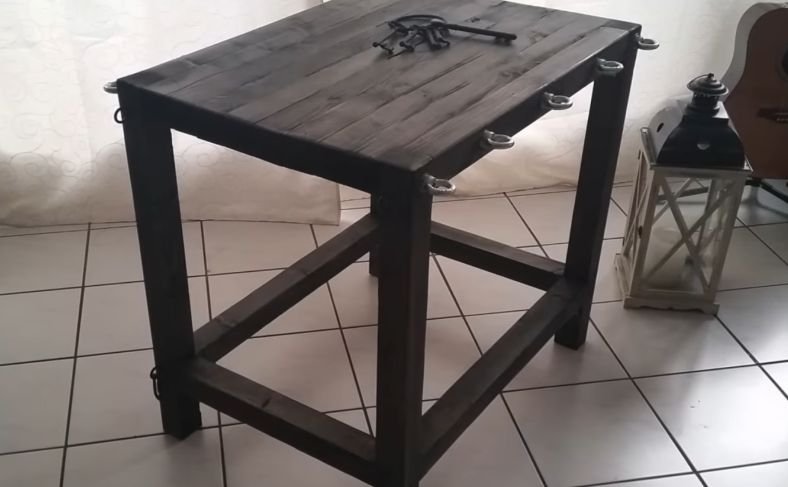Last updated on April 21st, 2025 at 12:29 pm
Get familiar with the world of bondage tables, and specialized BDSM furniture designed to securely immobilize participants for a variety of play activities.
Learn about different types of bondage tables, including flat, adjustable, foldable, and custom-built models, and discover how to use them safely.
Enhance your experience with additional BDSM tools and techniques, while ensuring proper communication and aftercare.
This comprehensive guide provides valuable insights for both novices and experienced practitioners looking to deepen their BDSM play.
Related: Get Familiar with BDSM Tools and Equipment
Key Takeaways
- Bondage tables securely immobilize participants for BDSM play, offering a variety of positions and interactions within a safe environment.
- Types of bondage tables include flat, adjustable, foldable, and custom-built models, each catering to specific needs and preferences.
- Safety involves clear communication, regular maintenance, proper positioning, and aftercare to ensure a comfortable and consensual experience.
- Enhance your bondage table play with additional tools, sensory deprivation devices, and role-playing scenarios to deepen the experience.
Table of Contents
- Key Takeaways
- What are Bondage Tables and Their Purpose?
- Types of Bondage Tables and Their Features
- Choosing the Right Table
- How to Use a Bondage Table Safely
- Improving Your Bondage Table Experience
- Conclusion
What are Bondage Tables and Their Purpose?
Bondage tables are specialized pieces of furniture designed primarily for BDSM play.
These tables serve the essential purpose of securely immobilizing a person, enabling various forms of play and interaction within a controlled and safe environment.
The primary function of a bondage table is to restrain an individual in a position that facilitates different types of BDSM activities, ranging from impact play to sensory deprivation.
Design Evolution
These tables come in numerous shapes and sizes, with designs tailored to cater to the diverse preferences and needs of participants in the BDSM community.
Some bondage tables are built with multiple restraining points, allowing for comprehensive and varied positioning, while others may be designed for specific types of play, such as spanking benches or medical play tables.
This variety ensures that everyone, from novices to experienced practitioners, finds a table that suits their particular interests and comfort levels.
Related: Guide to Bondage
Historical Development
The evolution of bondage tables can be traced through the historical development of BDSM paraphernalia.
Initially, makeshift solutions and rudimentary structures were employed for restraint purposes.
However, as the practice gained more acceptance and began to meld with modern crafting techniques, bondage tables evolved into sophisticated and intricate pieces of furniture.
This transformation not only enhanced their functionality but also their aesthetic appeal, contributing to their popularity.
Related: Ultimate Guide to BDSM Restraints
Contemporary Trends
In recent years, bondage tables have witnessed a surge in popularity, partly due to the increasing mainstream awareness and acceptance of BDSM activities.
Contemporary bondage tables often incorporate modern materials and advanced ergonomics, making them safer and more versatile than ever before.
The focus on safety, combined with aesthetic design, makes them a desirable addition for enthusiasts who wish to explore their sexuality within a boundary-respectful and consensual framework.
Related: What is BDSM Chastity?
Types of Bondage Tables and Their Features

Flat Tables
Flat tables are the most straightforward type of bondage table. They typically feature a flat surface made from materials such as wood or metal, often covered with padding for comfort.
These tables include multiple attachment points, enabling a range of restraints and bondage positions.
Popular models often come with leather restraints and are favored for their simplicity and durability.
Adjustable Tables
Adjustable tables offer versatility through their modifiable heights and angles.
These tables are designed to change the positioning of the restrained individual, providing a dynamic bondage experience.
Materials like reinforced metal and high-quality leather are commonly used, ensuring both sturdiness and comfort.
Some models also include motorized adjustment features, enhancing convenience and precision.
Related: Guide to BDSM Gag Play
Foldable Tables
Foldable tables prioritize portability and storage efficiency. Often constructed with lightweight yet durable materials such as aluminum or composite metals, these tables can be collapsed and stored away when not in use.
Despite their lightweight design, many foldable tables still offer ample padding and numerous attachment points, making them ideal for users with limited space or those who prefer discretion.
Custom-Built Tables
Custom-built bondage tables allow for personalization and unique designs tailored to specific preferences.
These tables can be made from various materials, including intricate woods, premium leathers, and custom metals, ensuring a bespoke experience.
Custom tables may also incorporate specialized features such as built-in shelves, additional padding, or personalized engravings, providing a unique and functional piece of furniture.
Related: How to Choose the Right BDSM Equipment for Your Need
Choosing the Right Table
When choosing a bondage table, it is important to consider one’s personal needs and preferences.
Factors such as the intended use, available space, and specific functionalities should guide the selection process.
For instance, someone seeking a multi-functional piece may lean towards an adjustable table, whereas a user with limited space might opt for a foldable model.
Understanding the distinct features of each type is essential to selecting a bondage table that enhances the overall experience while ensuring safety and comfort.
Related: What is BDSM Punishment?
How to Use a Bondage Table Safely
Communication and Consent
Using a bondage table safely requires a clear understanding of several key safety measures.
First and foremost, open and honest communication between partners is essential.
Discuss and establish clear boundaries, and always agree on a safe word that either partner can use to halt the activity at any time.
This ensures that the experience remains consensual and enjoyable for both parties.
Table Inspection and Maintenance
Before using the table, it is critical to ensure that it is both sturdy and stable. Check for any signs of wear and tear, particularly on the straps and attachment points.
Regular maintenance can prevent potential accidents.
A thorough inspection before each session can help identify any weak spots that may lead to discomfort or injury.
Proper Positioning
Proper positioning on the table is crucial to avoid unnecessary strain or injury.
Ensure that the person being restrained is in a comfortable position, avoiding extreme angles that could lead to muscle strain or restricted circulation.
It is wise to take frequent breaks to check on their comfort and well-being, adjusting positions as necessary to maintain comfort and safety.
Periodic Pauses and Communication
Using a bondage table should also involve periodic pauses to ensure ongoing comfort and to address any emerging concerns.
This practice not only helps in maintaining physical well-being but also encourage a sense of trust and security between partners.
Communication during these intervals is vital to ensure that any discomfort can be promptly addressed.
Related: BDSM Dungeon: Everything to Know
Aftercare
Aftercare is an essential component of any bondage session. Aftercare involves attending to any physical or emotional needs that may arise post-session.
This can include offering water, and blankets, or simply providing reassurance and comfort.
It allows both partners to transition smoothly back to their regular activities, strengthening the emotional and physical connections established during the session.
Related: Choosing Between Professional BDSM Tools and DIY
Improving Your Bondage Table Experience
Integrating Additional Tools and Toys
To make the most out of your bondage table encounters, it’s essential to harness a blend of creativity, proper use of tools, and continual learning.
Integrating additional BDSM tools and toys can significantly enhance the experience, offering diverse sensations and deepening the connection between partners.
Incorporating restraints, such as cuffs and ropes, can provide varying levels of immobilization, which is often a crucial aspect of bondage play.
Moreover, the introduction of floggers, paddles, and whips can add an element of sensory stimulation, creating an intricate balance between pleasure and pain.
Using Sensory Deprivation Devices
Sensory deprivation devices, such as blindfolds and noise-canceling headphones, can be powerful additions that heighten the experience by focusing the senses on touch and anticipation.
Furthermore, the versatility of a bondage table allows for the exploration of numerous positions and techniques that may not be possible elsewhere.
Experimenting with different setups can keep the scenarios fresh and exciting.
For instance, varying the height and angle of the table can offer unique access and new ways to apply restraints or administer sensations.
Exploring Role-Playing Scenarios
Role-playing scenarios are another vital aspect of enhancing the bondage table experience.
Embracing different personas and narratives can add depth and excitement to each session.
Whether you are exploring strict disciplinary themes, nurturing dynamics, or fantastical elements, creativity in role-play can transform a routine encounter into something extraordinary.
Learning and Workshops
Attending workshops or reading materials dedicated to bondage and BDSM can provide valuable skills and insights.
These can range from advanced knot techniques to innovative ways of incorporating various toys and tools, thereby enriching your experience.
Maintenance and Hygiene
Lastly, maintaining and cleaning your bondage table is crucial for its longevity and hygiene.
Regularly inspect the table for any signs of wear or damage, and address them promptly to ensure safety.
Clean the table surface and any attached equipment with appropriate disinfectants after each use to prevent the buildup of bacteria and to maintain a pleasant environment for future sessions.
By following these tips, you can ensure that your bondage table remains a durable and integral part of your BDSM play.
Conclusion
Bondage tables offer diverse and customizable options for BDSM play, enhancing experiences through various types and features.
Safety is paramount, requiring effective communication, careful maintenance, and thorough aftercare.
By integrating additional tools and techniques, and continually learning, enthusiasts can enrich their bondage play.
This guide provides valuable insights for both newcomers and seasoned practitioners, ensuring enjoyable and secure sessions.
References

